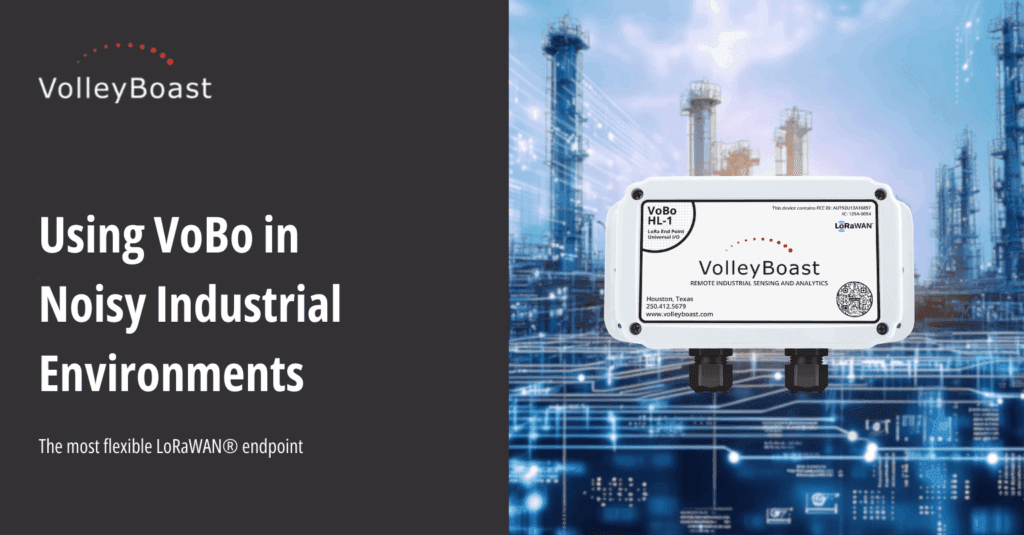LoRaWAN® is popular for enabling low-power, long-range communication between battery-powered devices and centralized gateways. When used with a VoBo in noisy industrial environments, it offers even greater value for connectivity, robustness, and versatility. In plants, refineries, and other electrically dense environments, VoBo bridges the gap between wired sensors and wireless LoRaWAN® networks, offering a reliable communication path, even when electromagnetic interference (EMI) is present.
What Are Noisy Industrial Environments?
Industrial environments are often filled with signal interference caused by machinery, motors, variable frequency drives, power lines, welding equipment, other radio devices, and more. These environments generate high levels of EMI and radio frequency (RF) noise that can degrade wireless communication, including lower signal quality, reduced range, and data loss.
Specific challenges include:
- EMI from surrounding equipment
- Co-channel/inter-channel interference from other LoRaWAN® devices
- Signal reflection and attenuation due to metal structures
- Susceptibility to intentional or unintentional jamming
This can make it difficult to monitor industrial environments. Even with these challenges, LoRaWAN® remains viable in these environments due to its robustness.
How LoRaWAN® Handles Noisy Environments
LoRaWAN® includes several technical features that allow it to remain effective even in dense, noisy RF environments.
Chirp Spread Spectrum (CSS)
LoRaWAN® uses CSS modulation, which spreads the signal across a wide bandwidth. This makes the transmission highly resistant to narrowband interference and enables successful decoding even in locations with high noise.
Sub-Gigahertz Operation
Operating in sub-GHz bands (915 MHz in the U.S. or 868 MHz in Europe) allows LoRaWAN® signals to penetrate walls, concrete, and work around metal obstructions more effectively than higher-frequency options.
Adaptive Data Rate (ADR)
ADR allows for dynamic adjustment of transmission parameters, including the spreading factor, data rate, and power level, based on current network conditions. This reduces airtime, lowers collisions, and maintains network efficiency and reliability.
Forward Error Correction (FEC)
Built-in error correction allows LoRaWAN® to detect and fix corrupted packets. This improves transmission reliability in difficult conditions caused by interference.
VoBo’s Role in Noisy Industrial Environments
Industrial monitoring is enhanced even further with the strategic use of VoBo endpoints. The VoBo enhances IIoT network capabilities by providing a rugged bridge between wired sensors and LoRaWAN®, designed specifically for harsh industrial environments. The VoBo works great around other wireless devices, structures, and metal objects.
Signal Consolidation
A VoBo can connect to multiple analog, digital, and serial RS485 Modbus RTU devices, consolidating their data into LoRaWAN® transmissions.
Reduced Cabling
By converting wired sensors into LoRaWAN®-enabled transmitters, VoBo often eliminates the need to run expensive communication and power cables when automating data collection.
Coordinated Data Collection
With VoBoSync, you can synchronize the data collection times of multiple VoBos and manage transmissions to avoid collisions and improve communication with the gateway. This is critical in environments with high wireless traffic, helping to eliminate data packet clashing, reduce retransmissions, and improve data reliability.
Edge Processing with VoBoAnalytics
VoBoAnalytics allows collected data to be analyzed on board the VoBo. This is great for reducing wireless traffic by sending only the analyzed results, which enhances system efficiency by reducing transmissions and the opportunity for data loss.
Pre-deployment Site Survey
Before deploying VoBos and LoRaWAN® gateways, a detailed RF site survey can provide useful information. A site survey helps identify:
- Signal quality across the site
- Areas with poor signal quality and plan improvements
- Signal path obstacles (walls, ducts, tanks)
- High-reflection zones (metallic surfaces)
Strategic VoBo and Gateway Placement
Strategically placing your VoBos and gateways can improve your signal strength and transmission reliability.
VoBo Placement
There are several things to consider when choosing the location to mount your VoBo.
- While VoBos need to be wired to their sensors, some sensors, like 4-20mA and Modbus, can tolerate longer connection cable lengths, allowing the VoBo to be positioned for optimal signal quality
- Maximize the line of sight (LOS) to the gateway by elevating the VoBo, but keep in mind that it will need to be accessible so the battery can be replaced.
- Clear temporary obstacles
- Mount outside if possible
- Avoid mounting the VoBo inside a box or container
Gateway Placement
The strategy for gateway placement becomes more important in noisy environments. A successful LoRaWAN® gateway placement in noisy industrial environments requires a combination of careful planning, strategic positioning, robust hardware selection, and an understanding of LoRaWAN®‘s strengths and limitations.
- Place gateways above the industrial floor (such as ceilings, rooftops)
- Mount the gateway or its antenna higher to improve the LOS to the endpoints
- Avoid metal enclosures
- Build redundancy with multiple gateways and partially overlapping coverage
By implementing these strategies, you can ensure a reliable and efficient LoRaWAN® network in even the most challenging industrial settings.
Build Network Resilience with Redundancy
Deploying multiple gateways increases your network’s reliability by allowing multiple reception points for each VoBo’s transmission.
This redundancy can:
- Improve data reception rates
- Reduce single-point failures
- Enhance load balancing in high-density locations
Redundant gateway coverage in different RF zones ensures consistent coverage and minimizes data loss.
Conclusion
LoRaWAN® provides a powerful platform for Industrial IoT in noisy environments when paired with a VoBo. Thanks to the robust LoRa radio, adaptive communication strategies, and smart endpoint design, VoBo-enabled systems deliver reliable, long-range connectivity in even the harshest RF environments. With proper site planning, deployment optimization, and interference planning, LoRaWAN® can thrive in the places where other wireless systems struggle.

